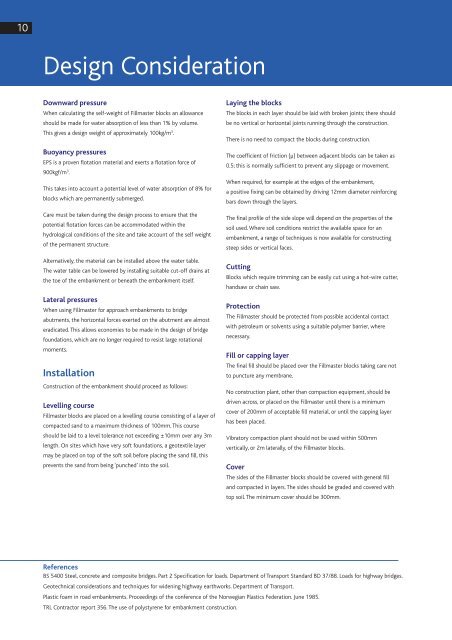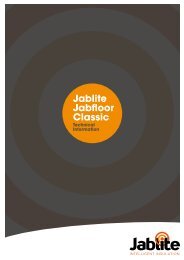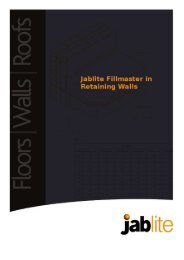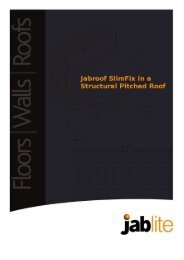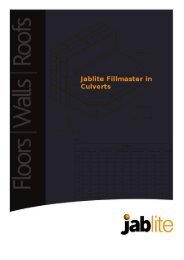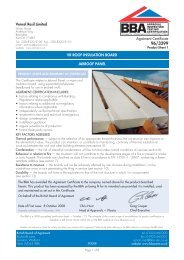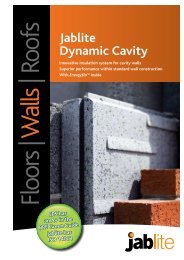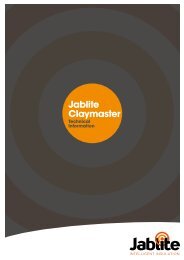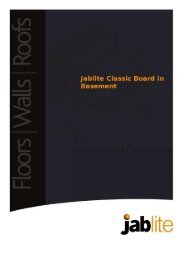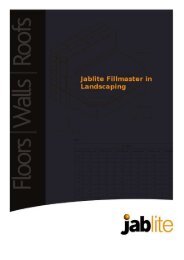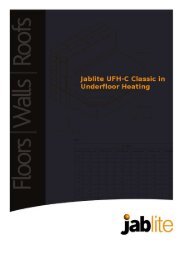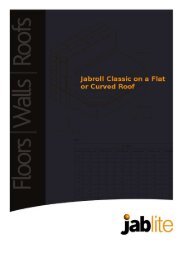Jablite Fillmaster in Noise Bunds
Jablite Fillmaster in Noise Bunds
Jablite Fillmaster in Noise Bunds
You also want an ePaper? Increase the reach of your titles
YUMPU automatically turns print PDFs into web optimized ePapers that Google loves.
10<br />
Design Consideration<br />
Downward pressure<br />
When calculat<strong>in</strong>g the self-weight of <strong>Fillmaster</strong> blocks an allowance<br />
should be made for water absorption of less than 1% by volume.<br />
This gives a design weight of approximately 100kg/m 3 .<br />
Buoyancy pressures<br />
EPS is a proven flotation material and exerts a flotation force of<br />
900kgf/m 3 .<br />
This takes <strong>in</strong>to account a potential level of water absorption of 8% for<br />
blocks which are permanently submerged.<br />
Care must be taken dur<strong>in</strong>g the design process to ensure that the<br />
potential flotation forces can be accommodated with<strong>in</strong> the<br />
hydrological conditions of the site and take account of the self weight<br />
of the permanent structure.<br />
Alternatively, the material can be <strong>in</strong>stalled above the water table.<br />
The water table can be lowered by <strong>in</strong>stall<strong>in</strong>g suitable cut-off dra<strong>in</strong>s at<br />
the toe of the embankment or beneath the embankment itself.<br />
Lateral pressures<br />
When us<strong>in</strong>g <strong>Fillmaster</strong> for approach embankments to bridge<br />
abutments, the horizontal forces exerted on the abutment are almost<br />
eradicated. This allows economies to be made <strong>in</strong> the design of bridge<br />
foundations, which are no longer required to resist large rotational<br />
moments.<br />
Installation<br />
Construction of the embankment should proceed as follows:<br />
Levell<strong>in</strong>g course<br />
<strong>Fillmaster</strong> blocks are placed on a levell<strong>in</strong>g course consist<strong>in</strong>g of a layer of<br />
compacted sand to a maximum thickness of 100mm. This course<br />
should be laid to a level tolerance not exceed<strong>in</strong>g ±10mm over any 3m<br />
length. On sites which have very soft foundations, a geotextile layer<br />
may be placed on top of the soft soil before plac<strong>in</strong>g the sand fill, this<br />
prevents the sand from be<strong>in</strong>g ‘punched’ <strong>in</strong>to the soil.<br />
Lay<strong>in</strong>g the blocks<br />
The blocks <strong>in</strong> each layer should be laid with broken jo<strong>in</strong>ts; there should<br />
be no vertical or horizontal jo<strong>in</strong>ts runn<strong>in</strong>g through the construction.<br />
There is no need to compact the blocks dur<strong>in</strong>g construction.<br />
The coefficient of friction (µ) between adjacent blocks can be taken as<br />
0.5; this is normally sufficient to prevent any slippage or movement.<br />
When required, for example at the edges of the embankment,<br />
a positive fix<strong>in</strong>g can be obta<strong>in</strong>ed by driv<strong>in</strong>g 12mm diameter re<strong>in</strong>forc<strong>in</strong>g<br />
bars down through the layers.<br />
The f<strong>in</strong>al profile of the side slope will depend on the properties of the<br />
soil used. Where soil conditions restrict the available space for an<br />
embankment, a range of techniques is now available for construct<strong>in</strong>g<br />
steep sides or vertical faces.<br />
Cutt<strong>in</strong>g<br />
Blocks which require trimm<strong>in</strong>g can be easily cut us<strong>in</strong>g a hot-wire cutter,<br />
handsaw or cha<strong>in</strong> saw.<br />
Protection<br />
The <strong>Fillmaster</strong> should be protected from possible accidental contact<br />
with petroleum or solvents us<strong>in</strong>g a suitable polymer barrier, where<br />
necessary.<br />
Fill or capp<strong>in</strong>g layer<br />
The f<strong>in</strong>al fill should be placed over the <strong>Fillmaster</strong> blocks tak<strong>in</strong>g care not<br />
to puncture any membrane.<br />
No construction plant, other than compaction equipment, should be<br />
driven across, or placed on the <strong>Fillmaster</strong> until there is a m<strong>in</strong>imum<br />
cover of 200mm of acceptable fill material, or until the capp<strong>in</strong>g layer<br />
has been placed.<br />
Vibratory compaction plant should not be used with<strong>in</strong> 500mm<br />
vertically, or 2m laterally, of the <strong>Fillmaster</strong> blocks.<br />
Cover<br />
The sides of the <strong>Fillmaster</strong> blocks should be covered with general fill<br />
and compacted <strong>in</strong> layers. The sides should be graded and covered with<br />
top soil. The m<strong>in</strong>imum cover should be 300mm.<br />
References<br />
BS 5400 Steel, concrete and composite bridges. Part 2 Specification for loads. Department of Transport Standard BD 37/88. Loads for highway bridges.<br />
Geotechnical considerations and techniques for widen<strong>in</strong>g highway earthworks. Department of Transport.<br />
Plastic foam <strong>in</strong> road embankments. Proceed<strong>in</strong>gs of the conference of the Norwegian Plastics Federation. June 1985.<br />
TRL Contractor report 356. The use of polystyrene for embankment construction.


